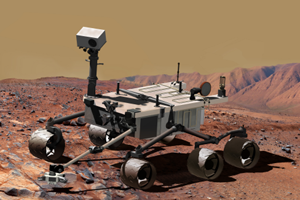 NASA's Mars Science Laboratory--artist conceptThey just keep getting bigger and better—and curiouser. The next generation Mars rover—The Mars Science Laboratory, "Curiosity"—is well off the drawing board and into its gestation phase…no longer just a gleam in the eye of robotics engineers and Marsologists.
NASA's Mars Science Laboratory--artist conceptThey just keep getting bigger and better—and curiouser. The next generation Mars rover—The Mars Science Laboratory, "Curiosity"—is well off the drawing board and into its gestation phase…no longer just a gleam in the eye of robotics engineers and Marsologists.
In 1997 there was the grandmother of all Mars rovers, Sojourner—a high-tech breadbox on wheels that crawled about the immediate area of its landing site in Ares Vallis, at the downstream end of an outflow structure. Sojourner (the rover portion of the overall Pathfinder lander) took 3-D images, performed chemical analyses on rocks, and successfully tested the "bounce around the landscape in an airbag" concept of landing on another planet.
Next up were Sojourner's successors—dare I say Prodigal Sons?—Spirit and Opportunity. A step up in stature, these self-sufficient science labs on wheels are about the size of small dinner tables with camera masts stretching 5 feet into the sky. Equipped with the almost prerequisite stereoscopic cameras, rock grinders, microscopic cameras, and a plethora of other instruments, these Mars Exploration Rovers far outlasted their original mission timelines—by years. Landing in 2004, Spirit only recently ceased transmission (temporarily or permanently is yet to be seen), and Opportunity is still roving, on its way to Endeavor Crater to see what it may see.
And now? It's bigger! It's better! It's the new Mars Science Laboratory, Curiosity! The next rover mission is currently being assembled and tested, in preparation for a launch in the Fall of 2011 and arrival at Mars early in 2012. Weighing in at 1,875 pounds (Earth-weight) and with a camera-mast height of nearly 7 feet, Curiosity will carry the most extensive and advanced set of instrumentation and analysis capability of any lander yet sent to Mars.
It's mission: to determine if the environment on Mars is, or ever was, capable of supporting microbial life.
